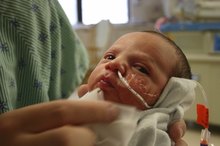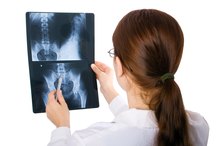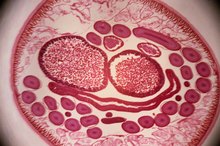How to Detect a Feeding Tube Infection
When a patient is unable to consume food on a long-term basis, a feeding tube may be required 1. A percutaneous endoscopic gastronomy (PEG) tube must be surgically inserted through the abdominal wall and into the stomach. Unfortunately, infection is a significant risk associated with a PEG tube. Infection can strike at any time, particularly in the days immediately following the insertion of the feeding tube. The following methods can be used to detect a feeding tube infection.
Begin by examining the skin surrounding the port where the feeding tube enters the body. Look for redness, inflammation, discharge, and (in some cases) a foul odor. In the days immediately following surgery to insert the PEG tube, there is an especially high risk of infection.
What Are the Side Effects of Feeding Tubes?
Learn More
Check the patient's temperature. Normal temperature is 98.6 degrees Fahrenheit. A person with an established and potentially life-threatening infection will have an elevated temperature. It's important to note that a patient with a less serious infection may not present with a fever until the infection worsens.
Check for abnormal stool, particularly stools that are black in color or very loose (diarrhea). When a patient with a PEG tube develops an infection, the bacteria from the infection will travel "downstream" into the intestines. This will cause the intestines to become inflamed; the inflammation inhibits the body's ability to absorb fluid from the meal and the stool will emerge in the form of diarrhea. In more severe cases, the intestines will begin to bleed as a result of the bacteria and inflammation. This causes bloody stool or a black stool. Black stool indicates bleeding in the upper GI tract, while red blood is "fresher," indicating bleeding in the lower GI tract.
Kidney Stone Infection Symptoms
Learn More
Look for symptoms of abdominal pain and nausea. A patient with a feeding tube infection will experience pain, discomfort and nausea. In young children or babies who cannot "report" pain, look for increased irritability, more frequent crying, and other signs of discomfort.
If a feeding tube infection is suspected, immediate medical attention is required, so transport the patient to the nearest hospital emergency room for care. If left untreated, infection can kill portions of the stomach, intestines and other organs, leading to a condition called necrosis. The infection can also enter the blood stream, causing a potentially deadly condition called sepsis.
Tips
In the days following the surgical procedure to insert the PEG tube, clean the wound at the site of the port--the spot where the tube enters the body--several times per day as directed by the physician.
Warnings
When caring for a person with a feeding tube, always err on the side of caution if a problem is suspected. Feeding tubes can become dislodged, infections can occur and these problems can be life-threatening. Seeking immediate medical care is essential if a problem is suspected.
Related Articles
References
- WebMD Facts on Feeding Tubes
- Sullivan SN. Functional abdominal bloating with distention. ISRN Gastroenterol. 2012;2012:721820. doi:10.5402/2012/721820
- The Oral Cancer Foundation. Nutrition/feeding systems.
- Philpott H, Garg M, Tomic D, Balasubramanian S, Sweis R. Dysphagia: Thinking outside the box. World J Gastroenterol. 2017;23(38):6942–6951. doi:10.3748/wjg.v23.i38.6942
- Blumenstein I, Shastri YM, Stein J. Gastroenteric tube feeding: techniques, problems and solutions. World J Gastroenterol. 2014;20(26):8505-24. doi:10.3748/wjg.v20.i26.8505
- U.S. National Library of Medicine. MedlinePlus. Jejunostomy feeding tube. Reviewed October 29, 2018.
- American Society for Gastrointestinal Endoscopy. Understanding percutaneous endoscopic gastrostomy (PEG).
- U.S. National Library of Medicine. MedlinePlus. Feeding tube insertion - gastrostomy. Reviewed May 20, 2018.
Tips
- In the days following the surgical procedure to insert the PEG tube, clean the wound at the site of the port--the spot where the tube enters the body--several times per day as directed by the physician.
Warnings
- When caring for a person with a feeding tube, always err on the side of caution if a problem is suspected. Feeding tubes can become dislodged, infections can occur and these problems can be life-threatening. Seeking immediate medical care is essential if a problem is suspected.









